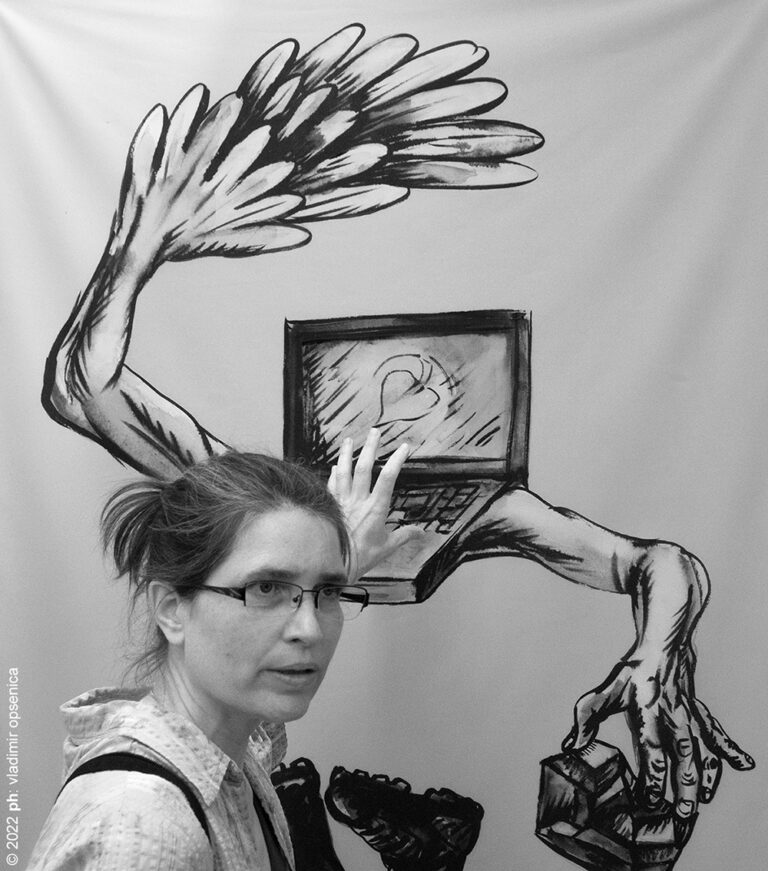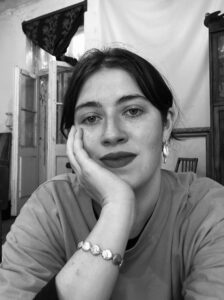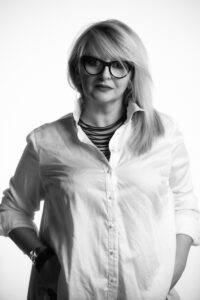Rena Raedle

– born in Germany in 1970, she lives and works in Belgrade and Berlin. She graduated in 2002 from the Faculty of Arts, University of Kassel, Germany. Since then, she has been developing a collaborative artistic practice with Vladan Jeremić. She explores the overlap between the areas of art and politics, exposing burning social contradictions. Her works include artistic installations and interventions that include drawings, prints and sculptures made from inexpensive materials such as textiles, cardboard and wood. Her works are kept in the following public collections: Thessaloniki State Museum of Contemporary Art, Thessaloniki; October Salon Collection, The Cultural Centre of Belgrade; Museum of Contemporary Art of Vojvodina, Novi Sad; Collection of The Museum of Yugoslavia, Belgrade; Van Abbemuseum, Eindhoven, Mudam, Luxembourg and Reina Sofia Museum, Madrid (with the Chto Delat art group).
I cannot separate the creation of art from social activity as a whole. At the core of my practice has always been the experience of contradictions. As peaks of some development, it is precisely the contradictions that open the field in which I can determine my current position and where I can formulate it and carry it out as a practice.
Art is fascinating because, unlike theory, it can encompass the sensory realization of certain conceptual constructions in concrete objects or actions. That way and up to a point, concepts can be tested in real life. In order for the ideas to even have a chance to survive beyond my imagination, I collaborated from the very beginning with other people in the process of creating art. I experienced authorship as a structurally imposed concept that conflicts with the effort of developing art as a social practice. It was there that I first clashed with politics within the field of art, with the standards and categories established in the art academy at that time1. However, that did not prevent me from continuing my artistic work as a dialogical practice, which has its significance not only in the form of the final product but also in the dialogical process of development from idea to realization.
I find it interesting to study the institution of art and its politics but I also consider the reference points of my practice are mostly set outside that institution, more precisely, in concrete social policies, discourses and movements, whether they be contemporary or historical. I witnessed the strong development of identity politics and the general culturalization of the politics of the 2000s that had an impact on the framework of my artistic practice, which at that moment was already articulated through joint work with Vladan Jeremić (since 2003), leading me to deal with the relationship between art and politics more explicitly. In Serbia, in the context of art funding mainly from European cultural funds2, or within exhibitions of the “Balkans” art scene abroad3, the artist was often asked to define his/her identity or to satisfy the idea of certain characteristics attributed to “the Balkans”, female, queer, or socially and politically engaged art. Perhaps it is symptomatic that, at that time, part of my practice was completely separated from the world of art. For several years, I have worked in the educational and publishing sectors4, engaged against historical revisionism in Serbia5, or relating to issues of erasing the historical experience of members of the Roma community and the situation in which they live today6.
Working with socially engaged people from disciplines such as sociology, education, and historical science has influenced my artistic practice so that I increasingly framed it as research. In addition, I see it as a specific type of intervention in given social circumstances7. I try to analyze them and provide a kind of commentary and answer that make sense, not only for me or a narrow artistic audience, but for all people who are interested in social issues. My research on a certain topic can last for years and that process involves interlocutors who follow my work and whose work, in turn, I follow. Through dialogue and detection of the meeting points and differences and then through various forms of joint action I find, again and again, the reward that this approach and way of artistic work brings me. It is the joy that comes from deep social connections. In this sense, art objects are notes or remnants of joint reflection and action8.
I think that much of artistic work today has a similar status to that of “care work,” a form of unpaid work directed toward community and the reproduction of order. Historically, this role was imposed on women and other persons who were considered the property of their masters. I am convinced that, due to the social expectation that says they take care of their environment “naturally”, it is harder for women to fight for adequate compensation and recognition for their involvement in all spheres of life. With the concepts of identity, belonging and origin, I associate a mixture of intimate feelings and the reactions from the environment, the content of which is constantly changing. I feel uncomfortable with the division of people according to these criteria, since in the final consequence, due to its exclusivity, that categorization leads to repression and violence.
Since childhood, I understood belonging to the female or male gender as a socially imposed role and already in kindergarten I developed certain survival techniques beyond following or fulfilling such patterns, and perhaps art is one of them.
The text is written in collaboration with Simona Ognjanović (2022).
1I studied during the 1990s at the Kunsthochschule Kassel in Germany.2I wrote a text about the impact of EU funds on culture in Serbia in 2009, later published under a pseudonym: Horrorkatze, “From Soros Realism to Creative Class“, in: Dora Hegyi (edit), Art Always Has Its Consequences, Sternberg Press, Berlin, 2011, p 191-192.
3This refers to exhibitions such as BLOOD & HONEY. Future's in the Balkans (curator: Harald Szeemann, 2003), In the Gorges of the Balkans (curator: René Block, 2003) and similar manifestations where the art scene of the former republics of Yugoslavia and the region, often called Southeast Europe, was presented.
4Link: Among others, the following publications were created at the time: Rena Raedle, Milovan Pisarri (ed.), Places of Suffering and the Anti - Fascist Struggles in Belgrade 1941–44, A Manual for Reading the City, FPI, Belgrade, 2013 and the web page: starosajmiste.info.
5The peak in the process of history revisionism in Serbia was the rehabilitation of the Chetnik commander and Nazi collaborator Draža Mihailović in 2015.
6I edited the first extensive historical research on the suffering of the Roma people in Serbia during the Second World War. See: Milovan Pisari, The Suffering of the Roma in Serbia during the Holocaust, FPI, Belgrade, 2014.
7Link: Some of the interventions were discursive in nature; others were performed as actions in public space. Examples: raedle-jeremic.net/pdfs/about_the_housing_question_full.pdf, raedle-jeremic.net/workers_collective.html, raedle-jeremic.net/deaf_shoes.html, or raedle-jeremic.net/fragile_presence_aktionsraum.html.
8Link: One of the work cycles was presented at the Transformatorium exhibition at the Museum of Contemporary Art of Vojvodina in Novi Sad in 2021. Accompanying publication can be found at: raedle-jeremic.net/pdfs/raedle-jeremic_transformatorium_msuv_2021_web.pdf.
– rođena je 1970. godine u Nemačkoj, a živi i radi u Beogradu i Berlinu. Diplomirala je 2002. na Fakultetu umetnosti, Univerzitet Kasel, Nemačka. Od tada razvija kolaborativnu umetničku praksu sa Vladanom Jeremićem. Bavi se istraživanjem preklapanja prostora umetnosti i politike, razotkrivajući goruće društvene kontradikcije. Njeni radovi obuhvataju instalacije i intervencije koje uključuju crteže, grafike i skulpture od jeftinih materijala poput tekstila, kartona i drveta. Njeni radovi nalaze se u sledećim javnim kolekcijama: Thessaloniki State Museum of Contemporary Art, Solun; Kolekcija Oktobarskog salona, Kulturni centar Beograda; Muzej savremene umetnosti Vojvodine, Novi Sad; Kolekcija Muzeja Jugoslavije, Beograd; Van Abbemuseum, Ajndhoven, MUDAM, Luksemburg i Museum Reina Sofia, Madrid (sa umetničkom grupom Chto Delat).
Stvaranje umetnosti ne mogu odvoijiti od društvenog delovanja u celini. U srži moje prakse oduvek se nalazilo iskustvo kontradikcija. U smislu krajnjih tačaka nekog razvoja, kontradikcije upravo otvaraju polje u kojem mogu odrediti svoju trenutnu poziciju, gde je mogu formulisati i izvesti kao praksu.
Umetnost je zanimljiva pošto, za razliku od teorije, može da obuhvati čulnu realizaciju određenih idejnih konstrukcija u konkretnim objektima ili delovanju. Na taj način, koncepti mogu da se testiraju donekle u stvarnom životu. Kako bi ideje uopšte imale šansu da opstanu i izvan moje imaginacije, sarađivala sam od samog početka sa drugim ljudima pri procesu stvaranja umetnosti. Autorstvo sam doživela kao strukturalno nametnuti koncept koji se kosi sa nastojanjem da se umetnost razvija kao društvena praksa. Upravo tu sam se prvi put sudarila sa politikom unutar polja umetnosti, sa standardima i kategorijama uspostavljenim na akademiji umetnosti u to vreme1. No, to me nije sprečilo da nastavim svoj umetnički rad kao dijalošku praksu, koja ima svoj značaj ne samo u formi finalnog proizvoda, nego isto tako u dijaloškom procesu razvitka od ideje do realizacije.
Zanimljivo mi je da promatram instituciju umetnosti i njene politike, ali smatram da se referentne tačke moje prakse nalaze mahom izvan te institucije, tačnije, u konkretnim društvenim politikama, diskursima i pokretima, bilo da su savremeni ili istorijski. Svedočila sam snažnom razvoju politike identiteta i opštoj kulturalizaciji politike dvehiljaditih godina, što je uticalo da se u okviru svoje umetničke prakse, koja se u tom trenutku već artikulisala kroz zajednički rad s Vladanom Jeremićem (od 2003. godine), sve eksplicitnije bavim odnosom između umetnosti i politike. U Srbiji, u kontekstu finansiranja umetnosti mahom iz evropskih fondova za kulturu2, ili u okviru izložbi „balkanske“ umetničke scene u inostranstvu3, od umetnice ili umetnika tražilo se često da se identitetski odredi ili pak da zadovolji predstavu o određenim karakteristikama pripisanim „balkanskoj“, ženskoj, kvir, ili socijalno i politički angažovanoj umetnosti. Možda je simptomatično da se u to vreme deo moje prakse potpuno odvajao od sveta umetnosti. Nekoliko godina sam se bavila edukativnim i izdavačkim delatnostima4, angažovanim u kontekstu borbi protiv istorijskog revizionizma u Srbiji5 ili vezujući se za pitanja brisanja istorijskog iskustva pripadnika i pripadnica Romske zajednice i situacije u kojoj danas žive6.
Rad sa društveno angažovanim ljudima iz disciplina kao što su sociologija, obrazovanje i istorijska nauka uticao je na moju umetničku praksu tako da sam je sve više postavljala kao istraživanje.
Pored toga, nju vidim kao specifičnu vrstu intervencije u zadate društvene okolnosti7. Pokušavam da ih analiziram i pružim jednu vrstu komentara i odgovora koji ima smisla ne samo za mene ili užu umetničku publiku, nego za sve ljude koje zanimaju društvene teme. Moje istraživanje određene tematike može da traje godinama, a u taj proces su uključeni sagovornici i saputnice, koji prate moj rad, i čiji rad ja takođe pratim. Kroz dijalog i prepoznavanje dodirnih tačaka i razlika, a potom i kroz različite oblike zajedničkog delovanja, ja iznova pronalazim nagradu koju mi donosi takav pristup i način umetničkog rada. To je radost koja proizlazi iz dubokih društvenih veza. Umetnički predmeti su u tom smislu beleške ili ostaci zajedničkog promišljanja i delovanja8.
Mislim da veliki deo umetničkog rada danas ima sličan status kao što ima „care work“, oblik neplaćenog rada koji je upućen zajednici i reprodukciji poretka. Istorijsko gledano, ova uloga je nametnuta ženama i drugim osobama koje su se smatrale vlasništvom svojih gospodara. Uverena sam, ženama je, zbog društvenog očekivanja da one „prirodno“ vode brigu o svojoj okolini, teže da se izbore za adekvatnu nadoknadu i priznanje za svoj angažman u svim sferama života. Sa pojmovima identitet, pripadnost i poreklo povezujem mešavinu intimnih osećanja i reakcija okoline, čiji se sadržaj stalno menja. Osećam nelagodu naspram deljenja ljudi prema tim kriterijumima, pošto u krajnoj konsekvenciji, zbog svoje isključivosti, kategorizacija dospeva do represije i nasilja. Pripadnost ženskom ili muškom rodu sam od detinjstva svhatala kao društveno nametnutu ulogu, a već u vrtiću sam razvila određene tehnike preživljavanja mimo ispunjavanja takvih obrazaca, možda je i umetnost jedna od njih.
Tekst je napisan u saradnji sa Simonom Ognjanović (2022).
1Studirala sam devedesetih na Kunsthochschule Kassel u Nemačkoj.2O uticaju EU fondova na kulturu u Srbiji napisala sam tekst 2009. kasnije objavljen pod pseudonimom: Horrorkatze, „From Soros Realism to Creative Class“, u: Dora Hegyi (ur.), Art Always Has Its Consequences, Sternberg Press, Berlin, 2011, str. 191-192.
3Ovde se misli na izložbe kao što su BLOOD & HONEY. Future's in the Balkans (kustos: Harald Szeemann, 2003), In the Gorges of the Balkans (kustos: René Block, 2003) i slične manifestacije na kojima je bila predstavljena umetnička scena bivših republika Jugoslavije i regiona, često nazivanog Southeast Europe.
4Tada su, između ostalog, nastale sledeće publikacije: Rena Raedle, Milovan Pisarri (ur.), Mesta stradanja i antifašističke borbe u Beogradu 1941–44. Priručnik za čitanje grada, FPI, Beograd, 2013., i vebstranica starosajmiste.info.
5Vrhunac revizije istorije u Srbiji predstavljao rehabilitacija četničkog komandanta i kolaboracioniste Draže Mihailovića 2015. godine.
6Uredila sam prvo obimno istorijsko istraživanje o stradanju Roma u Srbiji za vreme drugog Svetskog rata. Videti: Milovan Pisari, Stradanje Roma u Srbiji za vreme Holokausta, FPI, Beograd, 2014.
7Link: Neke od intervencija bile su diskurzivne prirode, druge su se izvele kao akcije u javnom prostoru. Primeri su: raedle-jeremic.net/pdfs/about_the_housing_question_full.pdf, raedle-jeremic.net/workers_collective.html, raedle-jeremic.net/deaf_shoes.html, ili raedle-jeremic.net/fragile_presence_aktionsraum.html.
8Link: Jedan od ciklusa radova je predstavljen na izložbi Transformatorijum u Muzeju savremene umetnosti Vojvodine u Novom Sadu 2021. godine. Prateća publikacija se može preduzeti sa: raedle-jeremic.net/pdfs/raedle-jeremic_transformatorium_msuv_2021_web.pdf.


